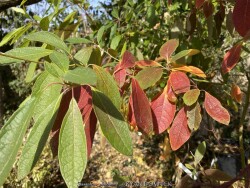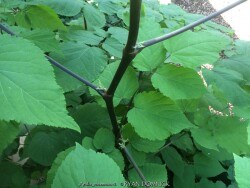

American Spikenard (Aralia racemosa) matures to 3-5' in height and has green flowers with attractive reddish purple berries in early fall. Spikenard is a true herbaceous perennial in that it dies back each fall and emerges from the ground up each spring. So large and broad, it is sometimes confused for a woodland shrub. It prefers wet to medium soil but tolerated dry-shade when mature in rich clay soils. Many woodland plants have already finished flowering when Spikenard blooms and shows off its beautiful berries. Cut the entire plant down in fall as there is no winter interest. In Kansas landscapes, use in Woodland gardens, sun dappled shade gardens, naturalized areas, wild gardens and native plant gardens. Plant as a specimen focal point or small grouping backdrop for shorter plants to contrast in the shade garden.


Dutchman's Pipe / Woolly Pipevine (Aristolochia tomentosa) is one of the most rapidly growing vines in out library capable of growing 15-30' in one summer! Native to eastern North America including Missouri, it typically occurs along moist woods and along streams. It can fill a large trellis or arbor with bright green foliage up to 12" across creating the most dense shade of any vine. It needs typical garden soil and regular moisture and is intolerant of drought. In Eastern Kansas, typically our 40 inches of rainfall is close to sufficient without much extra water if planted in good soils. The flowers are 1-2" across but are usually not noticed but is absolutely gorgeous with foliage alone.
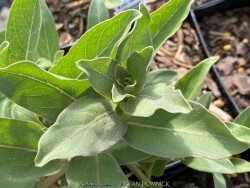

***Description for this perennial available with future update!***
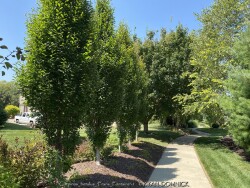

***Tree descriptions available with future update!***
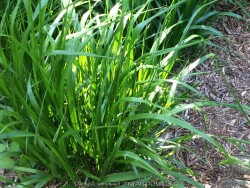

American Beakgrain (Diarrhena obovata) as a native ornamental grass found in rich woodlands in eastern North America. It features bright glossy green foliage about 2 feet tall. It is strongly vertical with little flopping until Seed heads weigh it down late in the season. With it being somewhat of a rarity to have an ornamental grass tolerate shade, American beak grass Along with inland sea oats and Korean Feather Grass help fill that niche. American beak grass prefers rich average to moist soil but will tolerate some dry shade of in rich soil. Seed heads are attractive but not persisting very long: it is an excellent source of food for birds and small mammals. Fall color is a gorgeous golden tint. Seedlings will germinate freely in the area around the mother plants. If this is not desired, simply keep the area mulched. Spreading by rhizomes will also occur after a few years. For the home garden in rich well irrigated areas, this species can be too aggressive. Use as a mass planting in any shaded area allowing extra room. However, in a difficult dry-shade garden, it will thrive, flower, and be relatively tame without much spread. Mulch will also stop self-seeding. It is one of the few plants that can survive under an established Silver Maple! Now if you need a plant to prevent soil erosion along streams, use this re-seeding to your advantage! As it reseeds easily and can expand aggressively within a couple of years, it makes a solid root mat in moist erosion-prone loam soils.
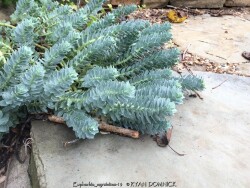

Donkeytail Spurge (Euphorbia myrsinites) is grown for its powder-blue/silver whorled foliage that is very architectural and symetrical. The stems creep along the ground in several directions from the main stem. Beautiful spring flowers are chartruse and foliage is solidly evergreen during winter and completely pest-free. Native to rocky and grassy places of southeastern Europe and Asia Minor, Donkeytail Spurge tolerates a wide range of growing conditions except excess moisture. Performance is best in poor soils, including rocky-sandy ones. Root rot can be a problem in poor drainage areas. It prefers full sun but can also grow well in full dry-shade. Individual plants tend to be short lived so allow some self seeding to occur within the group of plants. Due to self-seeding, it is considered a noxious weed in several western states and should not be planted in those areas. However, it is not a problem in Eastern Kansas or further East areas with over 35 inches of rainfall per year. Do not plant in rich moist soils or root rot will probably occur. Donkeytail Spurge is less adapted to consistent summer heat and humidity of zone 7b Southeast parts of the United States. With poisonous foliage, these plants resist deer and rabbit browsing. Wear gloves when handling this plant and avoid the milky sap. Great plant for berms or clammoring over retaining walls in hot West or South exposures in full sun or the opposite full dry-shade!
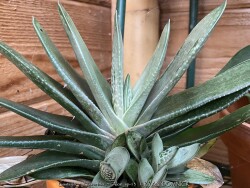

These succulents are usually spineless and grown for their beautiful shapes, color and texture. Gasteria / Haworthia / Aloe are usually grown as small patio or house plants in Kansas. In the wild, some species are hardy to below 20 degrees F. Grow in part sun to full shade with little extra watering except that which comes from rainfall. Repotting may or may not be needed depending on how large you want the plant to grow; plants can continue to grow and tolerate extremely root-bound pots but will eventually need thinned or repotted. If repotting, make sure to use a sharp draining low organic cactus mix with plenty of sand and perlite. To play is safe, potted plants are best moved in before night temperatures get below 45 degrees F. It is important to avoid the combination of wet and cold. Move to a bright interior window over the winter with no watering and keep above freezing. As a winter house plant, it will look presentable all winter long with just a few waterings. As a permanent house plant, provide bright light and allow the soil to dry between waterings for many years of carefree enjoyment. Generally if moving outside for the summer, keep in part to full shade. Some species will acclimate and thrive in full sun but be careful not to rush it or sunburning will occur; move into sun gradually over a few weeks. Potted plants are very low maintenance but avoid too much water or plants will rot.
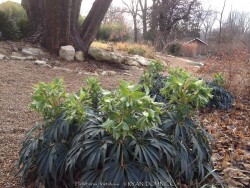

Bear Claw / Stinking Hellebore (Helleborus foetidus) is the ultimate dry-shade plant for eastern Kansas landscapes. Most hellebores are native to mountainous wooded regions of Europe and Asia with limestone bedrock and calcareous, humus-rich soils. They have everything a gardener might ask for; beautiful spring flowers, dependable dark green foliage, evergreen during winter, appreciation for alkaline soils, and ease of care with very low maintenance. Hellebores are one of the first perennials to start growing in the spring with flowering occurring even with hard freezes. Bear Claw Hellebore literally starts blooming in January and February in zone 6a. The drooping cup-shaped flowers appear in spring, and are yellowish-green, often with a purple edge to the five petal-like sepals on strongly upright stems. The flowers are very attractive to bees and other insects at a time of year when hardly any other plant (except Witchhazel / Hamamelis) is blooming. Despite its common name, it is not noticeably malodorous, although the foliage is pungent when crushed. Greenish flowers last incredibly long 2 to 3 months and finally turn brown in May and should be dead-headed. Summer and fall foliage is bear claw-like, dark green, dependable, and pest-free. Evergreen foliage is hardy to about -10°F with complete death occurring at about -15°F for unmulched plants. Desirable self-seeding will occur around mother plants. Individual plants of this species usually live for 3-4 years so it is advisable to allow a patch of different aged plants. Flowering usually occurs at 2-3 years. Hellebores do have an Achilles heel however; they cannot tolerate wet or poorly drained soils, not even slightly. In areas with too much rainfall or poorly drained soils, foliage diseases and root rot are likely to occur. Hellebores are also not the best choice for full sun, while they will survive, they will get foliage burn in the summer when over 100°F in afternoon sun. This hellebore is less adapted to consistent summer heat and humidity of zone 7b areas or South. With poisonous foliage, these plants resist deer and rabbit browsing. What a great plant for the dry shade garden! There are a few interesting and improved cultivars but are rarely available.
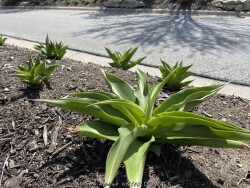

Hardy Manfreda (Manfreda virginica) are cute succulent perennials resembling a dwarf agave. The attractive green leaves are thick and fleshy with maroon spots extending to a point with a soft tip. Unusual, greenish-white, tubular flowers with conspicuous stamens are borne in a spike-like cluster atop 3-4' tall stalks. Some people prefer to trim the flowers for a more neat, compact look. Manfreda plants (also called American aloe) are native to eastern woods of Missouri, Oklahoma, Texas, Arkansas and much of the Southeast United States. This cold hardy succulent occupies an unusual niche: growing in poor shallow sandstone based soils in open woods and on sunny rock cliffs that dry out too quickly for most other plants to colonize. A good question is how does it find such isolated areas to colonize in the first place? Seeds are produced but do not spread far. Grow this small native gem in rock gardens, dry shade areas, in parking lot medians, in cracks between rocks, or on top of or in a retaining wall. It will re-seed to thicken the colony but only germinate in bare thin soils with no mulch. It will not tolerate competition in rich moist soils as other plants (or weeds) will shade it out. Most rock garden plants do not thrive indoors; aphids and spider mites seem to find them after a few months but overwintering indoors in a cool environment may work. If grown in pots and kept on the dry side, you may leave out all winter allowing to freeze solid; plants will go completely dormant and resume growth in the spring. Great low maintenance cold hardy succulent.
